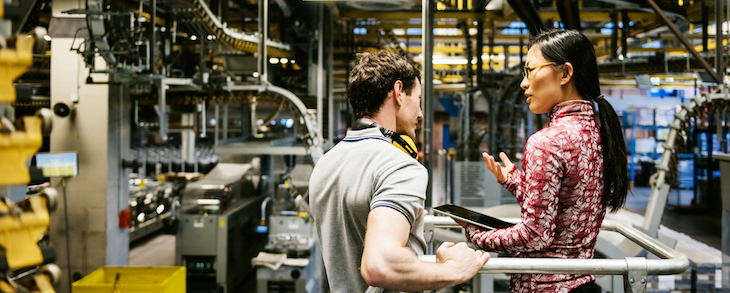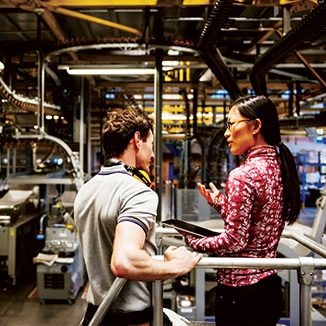

According to the 2017 Manufacturing Report from global professional services firm Sikich LLP, 80 percent of manufacturers said they are more optimistic about the U.S. economy compared to last year, and 66 percent were more optimistic about the manufacturing sector. 69 percent expected headcount to increase. Despite a positive outlook for the coming year, six common challenges for industrial equipment manufacturers remain. This blog post explores concerns about workforce quality, cybersecurity, research & development, digitization, sustainability, and servitization.
Workforce Quality is a Challenge for Industrial Manufacturers
In the Sikich report, nearly 60 percent of industrial manufacturers surveyed cited workforce challenges as a top priority, pointing to a lack of qualified workers as a barrier to business growth. “The use of advanced technologies across manufacturing operations requires workers with a higher level of training and skills,” says Jerry Murphy, partner-in-charge of Sikich’s manufacturing and distribution practice. “Our report found that while manufacturers recognize the gaps in workforce development, many simply are not doing enough to train and equip workers to thrive in today’s increasingly complex manufacturing operations.”
More than half of respondents to Sikich’s survey said their companies have no involvement with high schools, community colleges, or universities to develop skilled workers. In addition, more than 80 percent said they provide 40 hours or less of annual training per employee. This points to the need for manufacturers to prioritize workforce training and development within their organizations, as well as collaborate with schools and professional associations to train and recruit talent. Increasingly, this is essential for long-term viability and competitiveness in industrial manufacturing.
Cybersecurity Concerns for Industrial Manufacturers
As technology continues to change how manufacturers develop products and interact with customers, information technology security risks have increased. The report found that many manufacturers fail to take the necessary steps to protect their data. For example, 44 percent of respondents said they do not perform annual intrusion testing, in which security professionals attempt to infiltrate a company’s IT systems or applications to identify weaknesses.
Further, while training employees on cybersecurity best practices is necessary to ensure company-wide vigilance, nearly 70 percent of respondents said they do not conduct annual staff training. As the number of connected products in manufacturing operations increases, external and internal vulnerabilities abound in the industry. Manufacturers need to take preventative steps to secure valuable intellectual property and protect their investments in new high-tech manufacturing equipment, which can be exploited if not configured properly.
Research and Development in Industrial Manufacturing
According to the Sikich study, manufacturers view organic growth in existing domestic markets and new product or service development as the top opportunities for growth over the next 12 to 18 months. Despite the emphasis on new products, however, 78 percent of respondents said they invest 5 percent of sales or less in research and development. Moreover, nearly half do not take advantage of research and experimentation tax credits. “From workforce development to technology to financial planning, manufacturers cannot afford to grow complacent in an increasingly competitive marketplace,” notes Murphy. “The companies that stay ahead of industry trends and seek constant improvement will be the ones well-positioned to innovate and grow.”
Digitization Challenges in Industrial Manufacturing
According to Cerasis, “The Industrial Internet of Things (IIoT) is no longer the newest kid on the block. It is simply the most consistent kid on the block in manufacturing. Nearly every new piece of equipment or technology is inherently imbued with data capture and processing capabilities.” A recent report identified how every new upgrade leads to greater use of the IIoT in manufacturing, reports Supply Chain 24/7.
Manufacturers that have not upgraded systems in a while will be faced with added challenges in implementing digital processes, but making these changes today is essential to responding to changing consumer and business-to-business (B2B) demands tomorrow. This requires additional skills as well. Industrial manufacturers must figure out how to manage a superabundance of new data so that it becomes useful and not overwhelming, adapt technology to run their own supply chains and operations more seamlessly, monetize digitization, find talent adept at industrial software programming and analytics, and build strategic partnerships that won’t compete for market share.
Assess your readiness with our free Digital Thread Adoption Calculator.
Industrial Manufacturers Worry About Sustainability
According to James D. Sawyer of Advanced Manufacturing Media, sustainable manufacturing is starting to replace fossil fuel-based manufacturing. OPEC appears set to cut oil production to drive the cost of fuel up in 2017, but increases in domestic production, including offshore drilling rigs, will help alleviate rising fuel costs. Per the International Energy Agency (IEA), more renewable energy installations came online in 2015 and 2016 than fossil fuel-based installations. This includes the number of renewable installations, particularly wind farms that were brought online in the United States. Additionally, despite the current administration’s skeptical view of renewable energy, domestic manufacturers continue to look for sustainable alternatives to fossil fuels. Consumer pressure for sustainable initiatives will also extend to their assessment of manufacturers and their brands.
Commoditization of Services
To remain competitive and respond to the increasing trend of commoditization of services, manufacturers are looking to change their business models. According to The Manufacturer’s 2016 Annual Manufacturing Report, nearly half of manufacturers will improve profitability through value-added services. This reorientation will require a significant culture shift within traditional manufacturing organizations.






